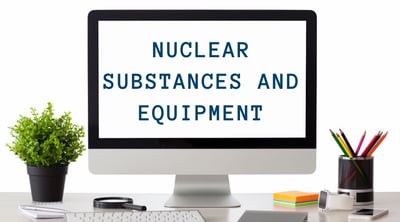Single Window Initiative (SWI) - Survival Guide for Nuclear Substances and Equipment
The new SWI landscape
The Single Window Initiative means several changes for importers:
- how you need to submit documentation is in flux;

- when that documentation is needed has changed; and
- which documentation is required is also shifting.
Our goal is to help you understand what is expected for the new “how, when, and what” of SWI requirements relating to the items you ship. These updates guide importers through specific commodities or categories of commodities, and the Participating Government Agencies (PGAs) that are affected.
How, when, and what
- Single Window Initiative requires all import documentation to be prepared and submitted before the shipment reaches customs.
- SWI is a new way of submitting documentation. All docs will be submitted using the Integrated Import Declaration (IID). Some of the requirements for how you submit are changing. For example: some documents that needed to be faxed now require an uploaded electronic image or just the document number.
- There may be changes to which documents are required under SWI.
- The launch date of SWI is still unknown, but it’s time to get proactive and adjust your workflow to ensure paperwork is ready before you ship.
Why importers need to know
Under the new SWI, it’s important that you understand which Participating Government Agencies (PGAs) are regulating your products. Some products are regulated by multiple PGAs, and the PGAs regulating your products may have changed under SWI.
Additionally, each PGA and the CBSA can issue penalties for incorrect and missing documents. Understanding what information and documentation is needed for clearance will make the clearance process into Canada smoother and more efficient.
Canadian Nuclear Safety Commission (CNSC) import program: Nuclear Substances and Equipment
The CBSA assists the Canadian Nuclear Safety Commission (CNSC) with the administration and enforcement of acts and regulations governing the import of nuclear substances, prescribed nuclear equipment, and prescribed nuclear information.
The SWI data elements required for release include:
Commodity characteristic
Commercial description
Commercial descriptions, and their essential description elements, vary depending on the categorization of the import.
Radiation device: device name (e.g., Gamma beam X200)
Nuclear substance: physical form of the substance (sealed, granules, powder etc.)
Controlled nuclear substance: brief description of the substance being imported
Nuclear equipment: brief description of the equipment being imported
Chemical specification
Chemical specifications, and their essential description elements, vary depending on the categorization of the import.
Radiation device: chemical specification of the intended material to contain (e.g., Cs-137)
Nuclear substance: chemical specification (e.g., Y-90)
Controlled nuclear substance: the specification that corresponds to the controlled nuclear substance (e.g., Plutonium) to be imported
Nuclear equipment: nuclear non-proliferation import and export control regulations (NNIECR) schedule part number as it appears on your import license (e.g., A.2.1.10)
Commodity identifier
The United Nations dangerous good (UNDG) code.
Radiation device: UNDG is mandatory
Nuclear substance: UNDG is mandatory
Controlled nuclear substance: UNDG is not required
Nuclear equipment: UNDG is not required
Quantity: number of packages
The count of packages for each retail package level
Package marking
Package certification: any regulatory-related marks (e.g. certifications) present on the retail packaging
Quantity: commodities
The total quantity of the commodities present in this commodity line must be provided
Quantity: chemical specifications
The quantity of the chemical specifications present in this commodity line must be provided using a compatible unit of measure of the item as presented in the CNSC license.
Radiation device: the activity of the source per device must be provided. Additional occurrences of this segment may be required.
Nuclear substance: the total activity/activity concentration, per isotope, of the sources must be provided
Controlled nuclear substance: total mass of the controlled nuclear substance must be provided
Commodity unit count
The quantity unit count or unit of measure.
Radiation device: the unit count of radiation devices, per model
Nuclear substance: the unit count of sources, per isotope
Nuclear equipment: the unit count, per equipment
Document type
Needed to provide information on licenses and certificates to regulate the import. Multiple document types may be required to be provided depending on the commodity.
- 7000 – CNSC (Canadian Nuclear Safety Commission) license
- 7001 – CNSC (Canadian Nuclear Safety Commission) device certificate
Document reference
7000 CNSC license: enter the exact license number as it appears on Section 1 of the CNSC license
7001 CNSC device certificate: enter the exact device certificate number as it appears on the CNSC device certificate
Importer contact information
Importer name, telephone number, or email address is required.
CNSC licensee
The party identifier used for identification purposes (i.e., Business Number) must belong to the licensee on the CNSC license.
Authorized party
Provide information about the party named in the license, permit, certificate, or other (LPCO).
Exporter contact information
Manufacturer name, telephone number, or email address is required.
Delivery party
The delivery destination must be provided.
For SWI, being proactive is your best strategy—gather all your information and documentation as far in advance as possible. Importers who know the requirements for the products they’re importing, and understand the new processes under SWI, will have a much smoother import experience.
SWI. It's what we do.

Latest Articles
- 7 ways Canadian importers reduce risk when ordering overseas
- Watch out for these extra charges on your freight bill
- Key differences between duty drawbacks and duty refunds for importers
- Mitigating container shortages and rising shipping prices for ocean imports
- How Canadian importers benefit from end use tariff codes and conditional relief
